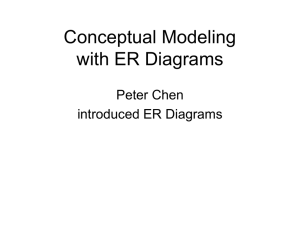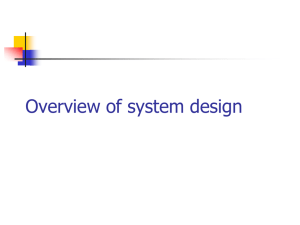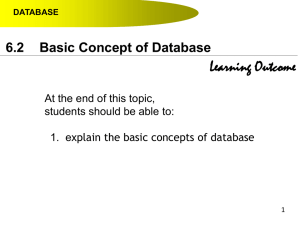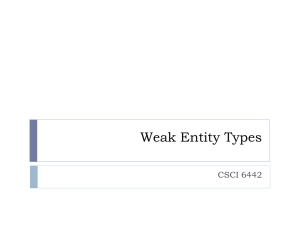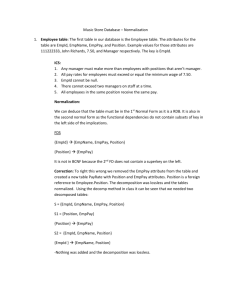Conceptual Modeling with ER Diagrams
advertisement
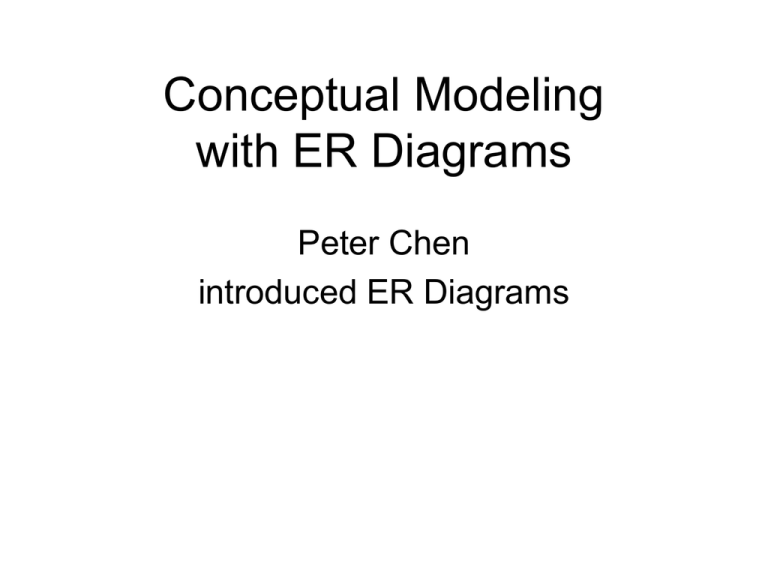
Conceptual Modeling with ER Diagrams Peter Chen introduced ER Diagrams E-R Modeling E-R Modeling is a design methodology for modeling the – Entities – Relationships using a diagram with specified shapes for entities, relationships, roles of entities in these relationships, and cardinality. E-R Diagram Conventions Symbol Meaning Entity Type Weak Entity Type Relationship Identifying Relationship Attribute ER-Diagram Conventions - CONTINUED Symbol Meaning Key Attribute Multivalued Attribute Composite Attribute E-R Modeling – Entity Sets, Attributes, Relationships Racquet Club Example • A Racquet Club has members with one year or two year contracts. • Members pay contract amount up front, quarterly, or monthly. • Members may reserve a court for the next day. – E-R Modeling Entity Sets, Attributes, Relationships Racquet Club Example Continued • Entity Sets – Members : Name, Start, Contract_Amount, Contract_Period, Initial_Balance, Member_ID – Payments : PayerID, Amount, Paid_Date, Payment_ID – Reservations : Member_ID, CourtNumber, Hour • Relations : – Member - Makes – Payment – Member - Makes - Reservation E-R diagrams for several relationship types Data Modeling – Racquet Club Example Keys, Cardinality Constraints and Participation Constraints • A key of a relation is a minimal set of attributes and roles which uniquely determine each entity. • A cardinality constraint m..n constrains the number of times a single entity can participate in a role of a relationship : m <= times <= n. • A participation constraint ensures that an entity will particpate at least this many times. ER-Diagram Cardinality Conventions Symbol Meaning Calculated Attribute Cardinality Constraints and Participation Constraints 0 .. * 0 .. 1 1 .. * 1 .. 1 Cardinality in the E-R model. 1 .. 2 means that at least 1 d must participate in the A relation with C and that not more that 2 d’s can participate. If A is represented by a table, then there is at least one row and not more than 2 rows with a single c value. Two ways to represent singlerole key constraints. Cardinality 0..1 can be represented by 0..1 or by Many-to-one, one-to-one, and many-to-many correspondences Example of an E-R diagram with an ISA hierarchy. Using IsA for data partitioning. New York Customer Pennsylvania Customer Participation constraints. Line-based representation vs. cardinality constraints. Entities, Relationships and Attributes • A entity is a object or event which needs to be tracked. Employee • A relationship relates entities in two or more entity sets. Employee Name Project Assigned Date • Attributes characterize entity sets and relationships. Relationship Types – Two Entity Set Relations Employee Assigned To Project Num-Hours Customer Project Will Pay For Fixed-Cost Relationship Types – One & Three Entity Set Relations One Set : ReportsTo( SupID, SubID ) subordinate Reports_To Employee supervisor Three Sets : Sale( ProdID, CustID,SuppID;Date) Customer Date Sold Supplier Product Price ER Diagrams for Payroll Payroll System Entity Sets & Relationships Customers : Name, Address,Phone,CustID Projects : Name,Description,ProjID,Total,CustID Employees : Name,SSNo,PayRate,EmpID TimeSheets : TSID,EmpID,Year,Month LaborCharges : TSID,ProjID,Description,Hours,Amount PayrollChecks : TSID,GrossPay,SSDeduction,WithHolding,NetPay CustomerInvoices : InvID,Year,Month,TotalCharge,SalesTax W2Statements : Year,EmpID,GrossPay,SSPayments,Withholding ER Diagram Customers : Name, Address,Phone,CustID Projects : Name,Description,ProjID,Total,CustID ER Diagrams for Payroll Phone Name Customer CustID Address Has Name Description Total CustID Projects ProjID ER Diagram Employees : Name,SSNo,PayRate,EmpID TimeSheets : TSID,EmpID,Year,Month LaborCharges : TSID,ProjID,Description,Hours,Amount PayrollChecks : TSID,GrossPay,SSDeduction,WithHolding ,NetPay ER Diagrams for Payroll PayRate Name Employee EmpID SSNo Has Year EmpID TimeSheet Month TSID Has Has TSID TSID ... Labor Charges PayCheck ... NetPay Amount The IS-A Relationship Employee Name SSNo Is-A Salaried Employee Salary disjoint Hourly Employee PayRate Construct an ER Diagram • Lawn Furniture Manufacturer • Stores Information for Catalog of products and parts • Stores Information for Manufacturing, including quantity on hand • Identify product entities (picnic table and lawn chair) with attributes • Identify relationships IsA and PartOf The Part-Of Relationship OutDoorProducts IsA Lawn_Chair Picnic_Table Price ProdNo Price Part_Of Top Seats Base Price ProdNo Quantity ProdNo From ER Diagrams to Relational Database Schema • Translating Entities Employee Name SSNo Type Termination HireDate Create Table Employee ( Name char(20), Type char(1), HireDate date, Termination date, SSNo char(9), Primary Key (SSNo) ) From ER Diagrams to Relational Database Schema • Translating Relationships Customer SaleDate Sold Supplier SaleID Product Price Create Table Sold ( SaleDate Date, Price Currency, SaleID autonumber, Customer Integer, Supplier Integer, Product Integer, Primary Key (SaleID), Foreign Key ( Customer ) References Customers( CustID), Foreign Key ( Supplier ) References Suppliers( SuppID ), Foreign Key ( Product ) References Products ProdID ) ) Translate into Schema Employee Name SSNo Is-A Salaried Employee Salary disjoint Hourly Employee PayRate Translate Into Schema OutDoorProducts IsA Lawn_Chair Picnic_Table Price ProdNo Price Part_Of Top Seats Base Price ProdNo Quantity ProdNo
